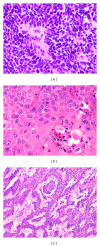Lung cancer: a classic example of tumor escape and progression while providing opportunities for immunological intervention
- PMID: 22899945
- PMCID: PMC3414063
- DOI: 10.1155/2012/160724
Lung cancer: a classic example of tumor escape and progression while providing opportunities for immunological intervention
Abstract
Lung cancers remain one of the most common and deadly cancers in the world today (12.5% of newly diagnosed cancers) despite current advances in chemo- and radiation therapies. Often, by the time these tumors are diagnosed, they have already metastasized. These tumors demonstrate the classic hallmarks of cancer in that they have advanced defensive strategies allowing them to escape various standard oncological treatments. Immunotherapy is making inroads towards effectively treating other fatal cancers, such as melanoma, glioblastoma multiforme, and castrate-resistant prostate cancers. This paper will cover the escape mechanisms of bronchogenic lung cancer that must be overcome before they can be successfully treated. We also review the history of immunotherapy directed towards lung cancers.
Figures


References
-
- Hecht SS. Tobacco smoke carcinogens and lung cancer. Journal of the National Cancer Institute. 1999;91(14):1194–1210. - PubMed
-
- Paez JG, Jänne PA, Lee JC, et al. EGFR mutations in lung, cancer: correlation with clinical response to gefitinib therapy. Science. 2004;304(5676):1497–1500. - PubMed
-
- Kosaka T, Yatabe Y, Endoh H, Kuwano H, Takahashi T, Mitsudomi T. Mutations of the epidermal growth factor receptor gene in lung cancer: biological and clinical implications. Cancer Research. 2004;64(24):8919–8923. - PubMed
Publication types
MeSH terms
Substances
LinkOut - more resources
Full Text Sources
Other Literature Sources
Medical

